Disaster Management using IoT: Internet Technology Strategy Report
VerifiedAdded on 2023/05/31
|6
|1521
|201
Report
AI Summary
This report delves into the application of internet technology strategies for effective disaster management, addressing key challenges and potential solutions. It examines disaster management phases, including mitigation, preparedness, response, and recovery, highlighting the importance of resource allocation and communication. The article proposes the use of IoT technologies to enable rapid communication through dynamic IP networks and employs a stable matching algorithm for safe resource allocation. Simulation results are analyzed to resolve problems related to establishing communication networks, providing medical treatment, and rescuing individuals, utilizing resources such as military force, volunteers, and medical assistance. The report also discusses activity classification and resource prioritization using the FCFS approach and a proposed model, emphasizing the importance of stable allocation for saving lives. Furthermore, it addresses the issue of online plagiarism among students, exploring factors such as laziness, pressure, and lack of confidence, and suggests measures to mitigate this concern.
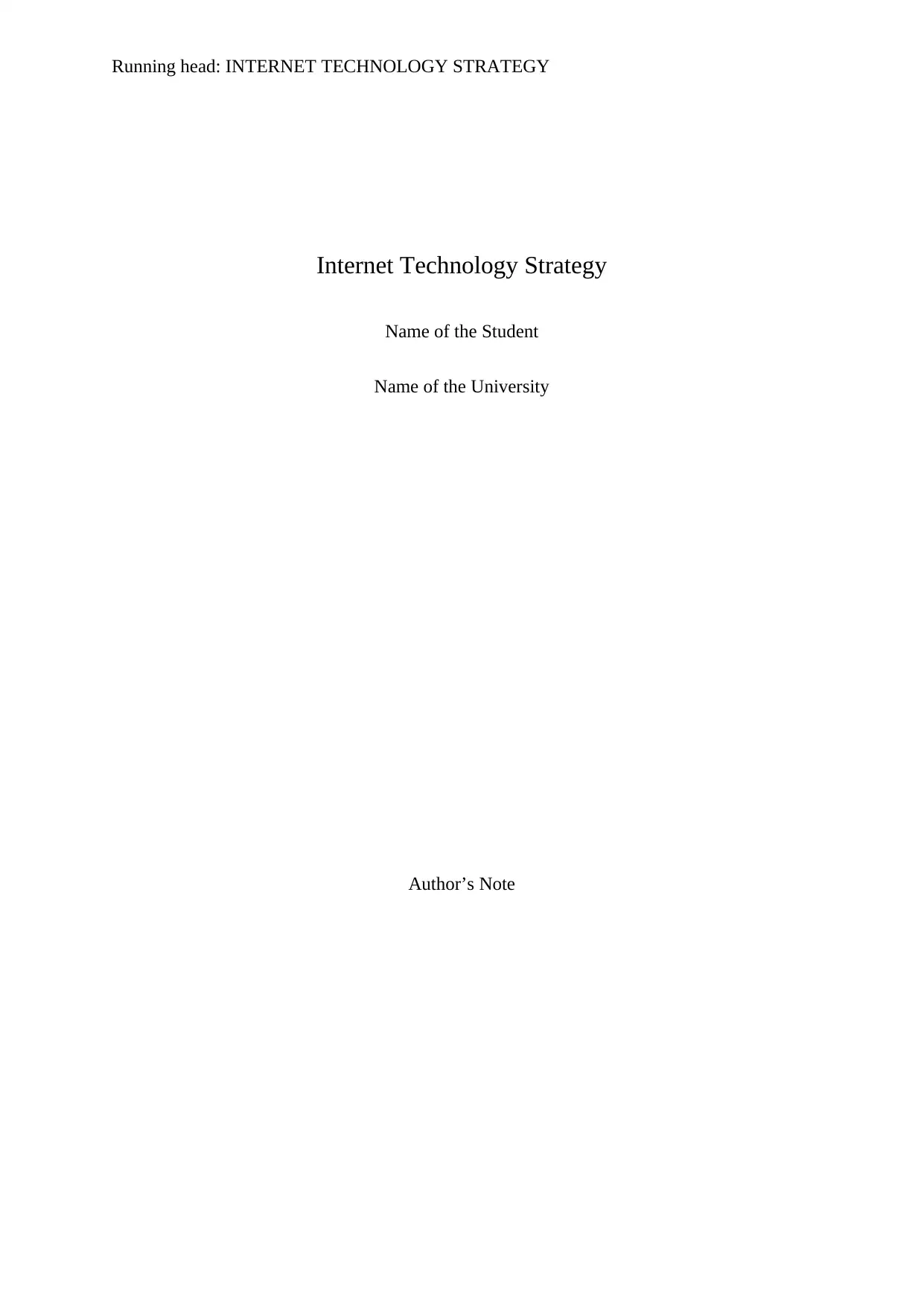
Running head: INTERNET TECHNOLOGY STRATEGY
Internet Technology Strategy
Name of the Student
Name of the University
Author’s Note
Internet Technology Strategy
Name of the Student
Name of the University
Author’s Note
Paraphrase This Document
Need a fresh take? Get an instant paraphrase of this document with our AI Paraphraser
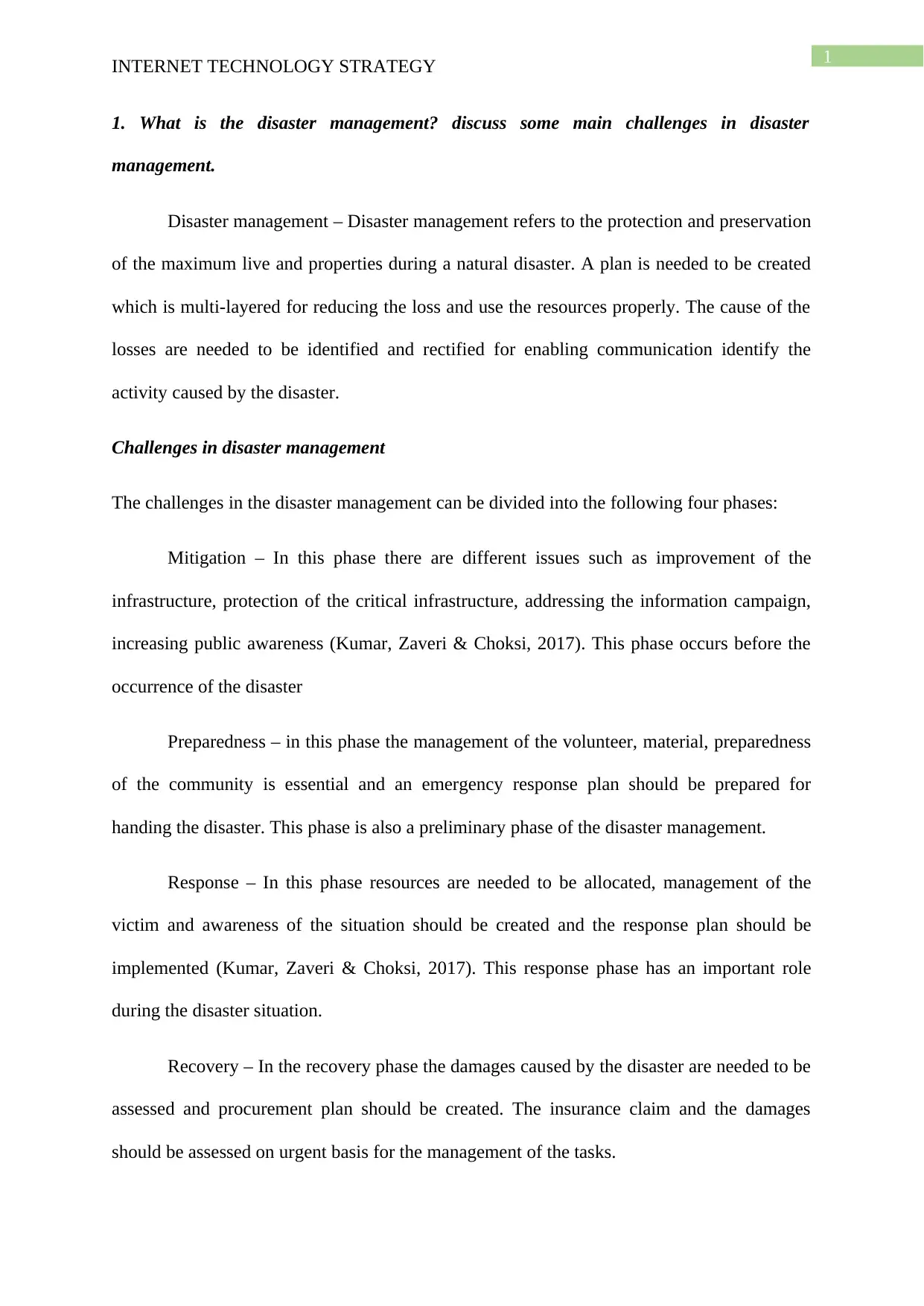
1
INTERNET TECHNOLOGY STRATEGY
1. What is the disaster management? discuss some main challenges in disaster
management.
Disaster management – Disaster management refers to the protection and preservation
of the maximum live and properties during a natural disaster. A plan is needed to be created
which is multi-layered for reducing the loss and use the resources properly. The cause of the
losses are needed to be identified and rectified for enabling communication identify the
activity caused by the disaster.
Challenges in disaster management
The challenges in the disaster management can be divided into the following four phases:
Mitigation – In this phase there are different issues such as improvement of the
infrastructure, protection of the critical infrastructure, addressing the information campaign,
increasing public awareness (Kumar, Zaveri & Choksi, 2017). This phase occurs before the
occurrence of the disaster
Preparedness – in this phase the management of the volunteer, material, preparedness
of the community is essential and an emergency response plan should be prepared for
handing the disaster. This phase is also a preliminary phase of the disaster management.
Response – In this phase resources are needed to be allocated, management of the
victim and awareness of the situation should be created and the response plan should be
implemented (Kumar, Zaveri & Choksi, 2017). This response phase has an important role
during the disaster situation.
Recovery – In the recovery phase the damages caused by the disaster are needed to be
assessed and procurement plan should be created. The insurance claim and the damages
should be assessed on urgent basis for the management of the tasks.
INTERNET TECHNOLOGY STRATEGY
1. What is the disaster management? discuss some main challenges in disaster
management.
Disaster management – Disaster management refers to the protection and preservation
of the maximum live and properties during a natural disaster. A plan is needed to be created
which is multi-layered for reducing the loss and use the resources properly. The cause of the
losses are needed to be identified and rectified for enabling communication identify the
activity caused by the disaster.
Challenges in disaster management
The challenges in the disaster management can be divided into the following four phases:
Mitigation – In this phase there are different issues such as improvement of the
infrastructure, protection of the critical infrastructure, addressing the information campaign,
increasing public awareness (Kumar, Zaveri & Choksi, 2017). This phase occurs before the
occurrence of the disaster
Preparedness – in this phase the management of the volunteer, material, preparedness
of the community is essential and an emergency response plan should be prepared for
handing the disaster. This phase is also a preliminary phase of the disaster management.
Response – In this phase resources are needed to be allocated, management of the
victim and awareness of the situation should be created and the response plan should be
implemented (Kumar, Zaveri & Choksi, 2017). This response phase has an important role
during the disaster situation.
Recovery – In the recovery phase the damages caused by the disaster are needed to be
assessed and procurement plan should be created. The insurance claim and the damages
should be assessed on urgent basis for the management of the tasks.
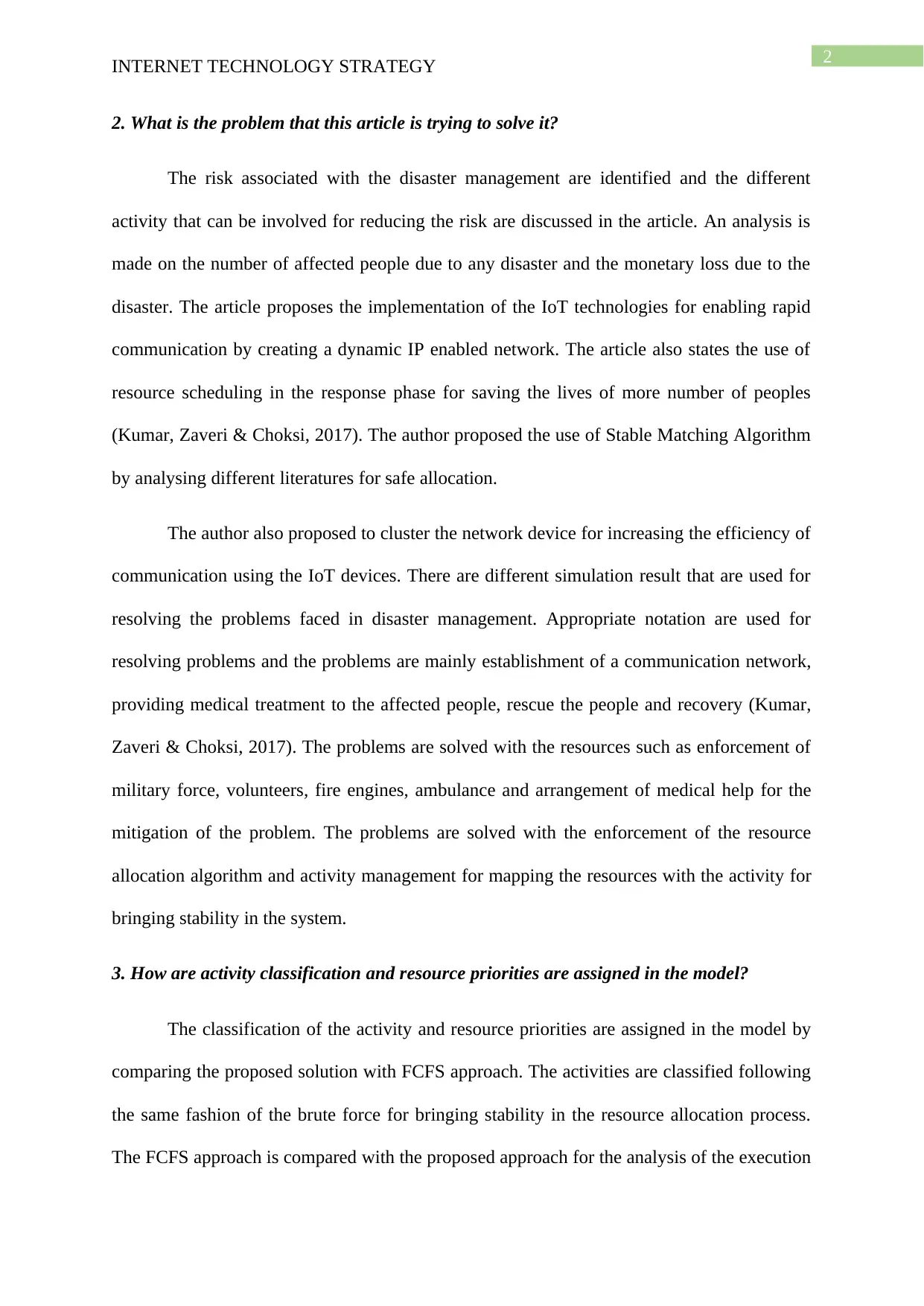
2
INTERNET TECHNOLOGY STRATEGY
2. What is the problem that this article is trying to solve it?
The risk associated with the disaster management are identified and the different
activity that can be involved for reducing the risk are discussed in the article. An analysis is
made on the number of affected people due to any disaster and the monetary loss due to the
disaster. The article proposes the implementation of the IoT technologies for enabling rapid
communication by creating a dynamic IP enabled network. The article also states the use of
resource scheduling in the response phase for saving the lives of more number of peoples
(Kumar, Zaveri & Choksi, 2017). The author proposed the use of Stable Matching Algorithm
by analysing different literatures for safe allocation.
The author also proposed to cluster the network device for increasing the efficiency of
communication using the IoT devices. There are different simulation result that are used for
resolving the problems faced in disaster management. Appropriate notation are used for
resolving problems and the problems are mainly establishment of a communication network,
providing medical treatment to the affected people, rescue the people and recovery (Kumar,
Zaveri & Choksi, 2017). The problems are solved with the resources such as enforcement of
military force, volunteers, fire engines, ambulance and arrangement of medical help for the
mitigation of the problem. The problems are solved with the enforcement of the resource
allocation algorithm and activity management for mapping the resources with the activity for
bringing stability in the system.
3. How are activity classification and resource priorities are assigned in the model?
The classification of the activity and resource priorities are assigned in the model by
comparing the proposed solution with FCFS approach. The activities are classified following
the same fashion of the brute force for bringing stability in the resource allocation process.
The FCFS approach is compared with the proposed approach for the analysis of the execution
INTERNET TECHNOLOGY STRATEGY
2. What is the problem that this article is trying to solve it?
The risk associated with the disaster management are identified and the different
activity that can be involved for reducing the risk are discussed in the article. An analysis is
made on the number of affected people due to any disaster and the monetary loss due to the
disaster. The article proposes the implementation of the IoT technologies for enabling rapid
communication by creating a dynamic IP enabled network. The article also states the use of
resource scheduling in the response phase for saving the lives of more number of peoples
(Kumar, Zaveri & Choksi, 2017). The author proposed the use of Stable Matching Algorithm
by analysing different literatures for safe allocation.
The author also proposed to cluster the network device for increasing the efficiency of
communication using the IoT devices. There are different simulation result that are used for
resolving the problems faced in disaster management. Appropriate notation are used for
resolving problems and the problems are mainly establishment of a communication network,
providing medical treatment to the affected people, rescue the people and recovery (Kumar,
Zaveri & Choksi, 2017). The problems are solved with the resources such as enforcement of
military force, volunteers, fire engines, ambulance and arrangement of medical help for the
mitigation of the problem. The problems are solved with the enforcement of the resource
allocation algorithm and activity management for mapping the resources with the activity for
bringing stability in the system.
3. How are activity classification and resource priorities are assigned in the model?
The classification of the activity and resource priorities are assigned in the model by
comparing the proposed solution with FCFS approach. The activities are classified following
the same fashion of the brute force for bringing stability in the resource allocation process.
The FCFS approach is compared with the proposed approach for the analysis of the execution
⊘ This is a preview!⊘
Do you want full access?
Subscribe today to unlock all pages.

Trusted by 1+ million students worldwide
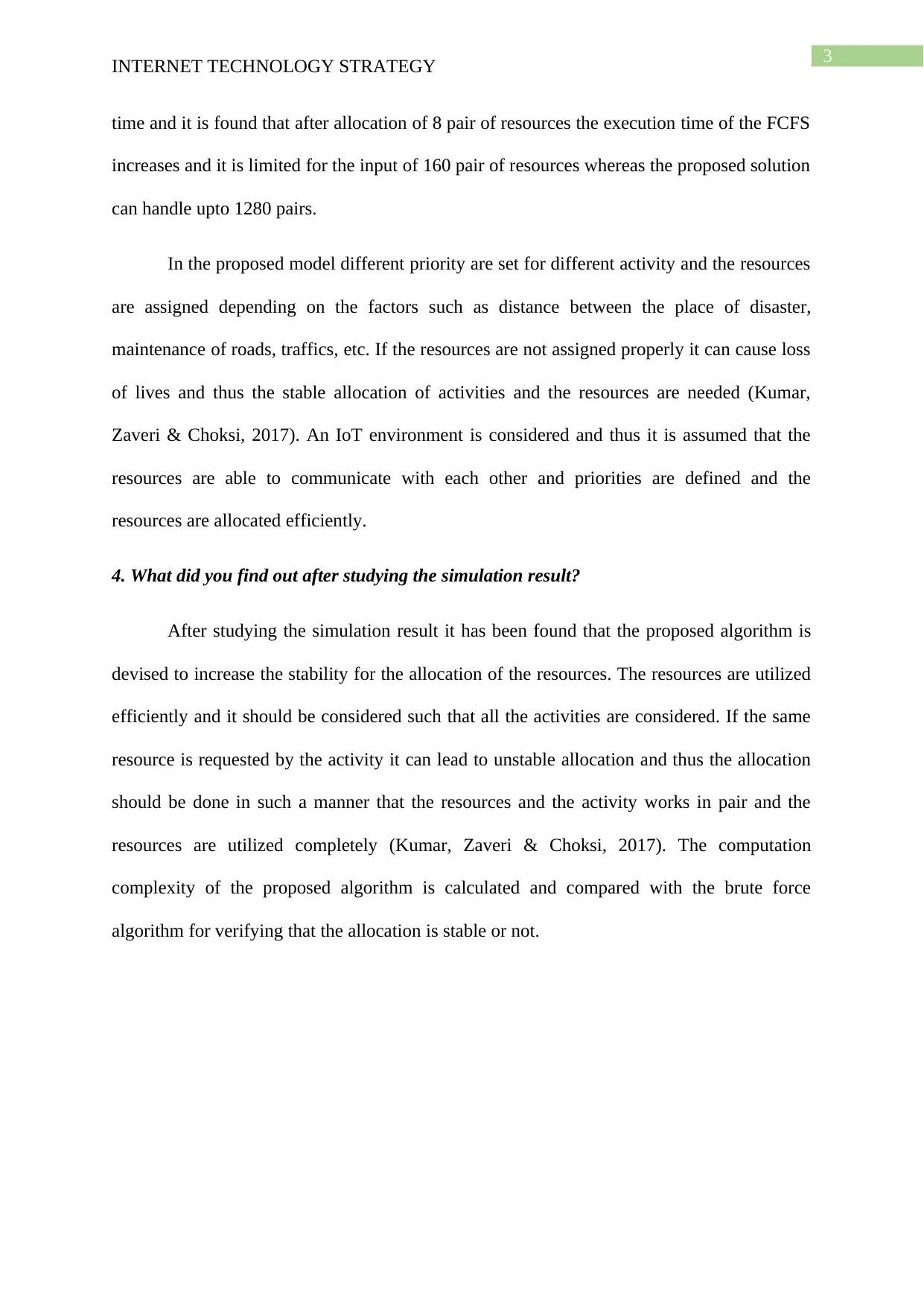
3
INTERNET TECHNOLOGY STRATEGY
time and it is found that after allocation of 8 pair of resources the execution time of the FCFS
increases and it is limited for the input of 160 pair of resources whereas the proposed solution
can handle upto 1280 pairs.
In the proposed model different priority are set for different activity and the resources
are assigned depending on the factors such as distance between the place of disaster,
maintenance of roads, traffics, etc. If the resources are not assigned properly it can cause loss
of lives and thus the stable allocation of activities and the resources are needed (Kumar,
Zaveri & Choksi, 2017). An IoT environment is considered and thus it is assumed that the
resources are able to communicate with each other and priorities are defined and the
resources are allocated efficiently.
4. What did you find out after studying the simulation result?
After studying the simulation result it has been found that the proposed algorithm is
devised to increase the stability for the allocation of the resources. The resources are utilized
efficiently and it should be considered such that all the activities are considered. If the same
resource is requested by the activity it can lead to unstable allocation and thus the allocation
should be done in such a manner that the resources and the activity works in pair and the
resources are utilized completely (Kumar, Zaveri & Choksi, 2017). The computation
complexity of the proposed algorithm is calculated and compared with the brute force
algorithm for verifying that the allocation is stable or not.
INTERNET TECHNOLOGY STRATEGY
time and it is found that after allocation of 8 pair of resources the execution time of the FCFS
increases and it is limited for the input of 160 pair of resources whereas the proposed solution
can handle upto 1280 pairs.
In the proposed model different priority are set for different activity and the resources
are assigned depending on the factors such as distance between the place of disaster,
maintenance of roads, traffics, etc. If the resources are not assigned properly it can cause loss
of lives and thus the stable allocation of activities and the resources are needed (Kumar,
Zaveri & Choksi, 2017). An IoT environment is considered and thus it is assumed that the
resources are able to communicate with each other and priorities are defined and the
resources are allocated efficiently.
4. What did you find out after studying the simulation result?
After studying the simulation result it has been found that the proposed algorithm is
devised to increase the stability for the allocation of the resources. The resources are utilized
efficiently and it should be considered such that all the activities are considered. If the same
resource is requested by the activity it can lead to unstable allocation and thus the allocation
should be done in such a manner that the resources and the activity works in pair and the
resources are utilized completely (Kumar, Zaveri & Choksi, 2017). The computation
complexity of the proposed algorithm is calculated and compared with the brute force
algorithm for verifying that the allocation is stable or not.
Paraphrase This Document
Need a fresh take? Get an instant paraphrase of this document with our AI Paraphraser
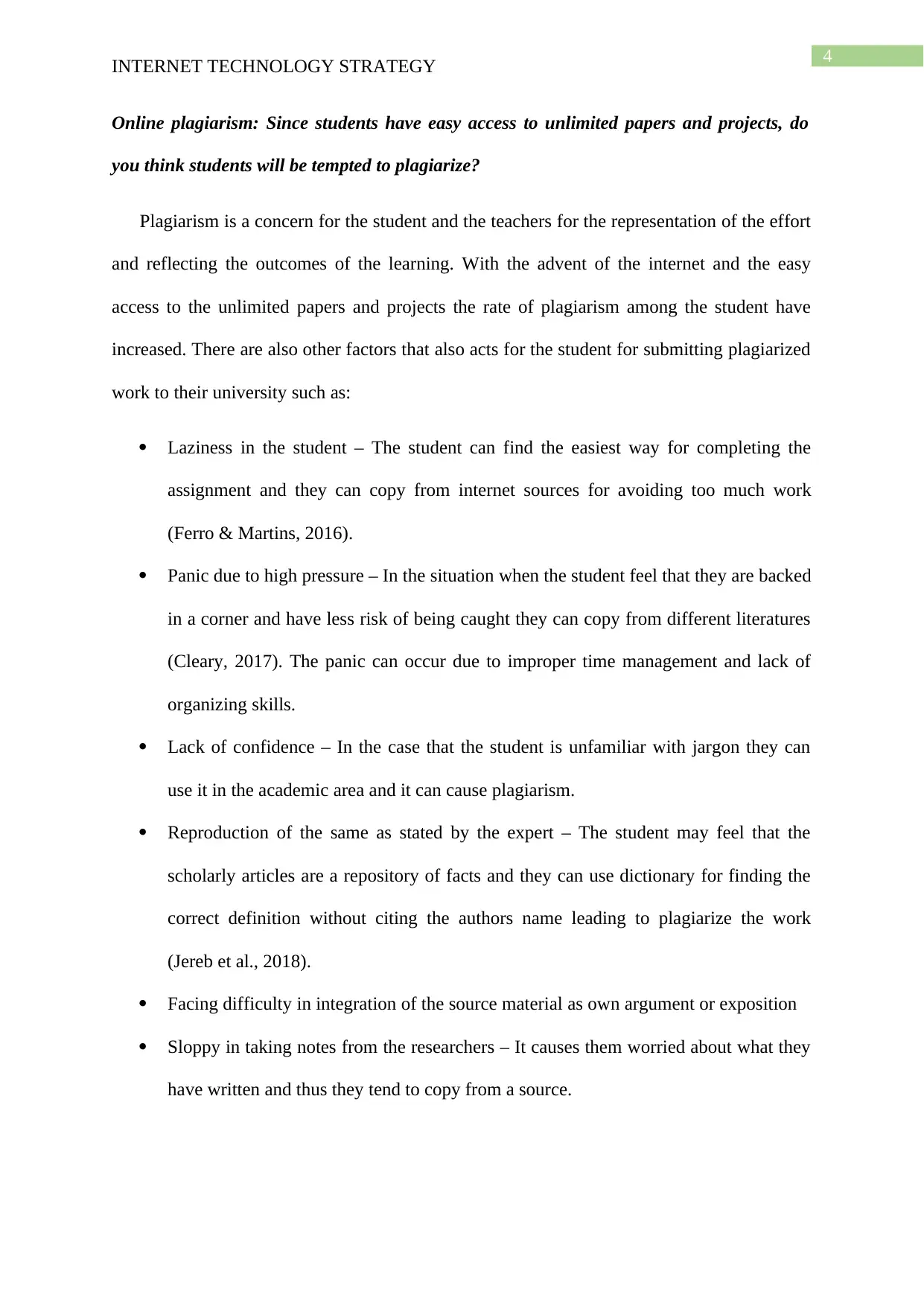
4
INTERNET TECHNOLOGY STRATEGY
Online plagiarism: Since students have easy access to unlimited papers and projects, do
you think students will be tempted to plagiarize?
Plagiarism is a concern for the student and the teachers for the representation of the effort
and reflecting the outcomes of the learning. With the advent of the internet and the easy
access to the unlimited papers and projects the rate of plagiarism among the student have
increased. There are also other factors that also acts for the student for submitting plagiarized
work to their university such as:
Laziness in the student – The student can find the easiest way for completing the
assignment and they can copy from internet sources for avoiding too much work
(Ferro & Martins, 2016).
Panic due to high pressure – In the situation when the student feel that they are backed
in a corner and have less risk of being caught they can copy from different literatures
(Cleary, 2017). The panic can occur due to improper time management and lack of
organizing skills.
Lack of confidence – In the case that the student is unfamiliar with jargon they can
use it in the academic area and it can cause plagiarism.
Reproduction of the same as stated by the expert – The student may feel that the
scholarly articles are a repository of facts and they can use dictionary for finding the
correct definition without citing the authors name leading to plagiarize the work
(Jereb et al., 2018).
Facing difficulty in integration of the source material as own argument or exposition
Sloppy in taking notes from the researchers – It causes them worried about what they
have written and thus they tend to copy from a source.
INTERNET TECHNOLOGY STRATEGY
Online plagiarism: Since students have easy access to unlimited papers and projects, do
you think students will be tempted to plagiarize?
Plagiarism is a concern for the student and the teachers for the representation of the effort
and reflecting the outcomes of the learning. With the advent of the internet and the easy
access to the unlimited papers and projects the rate of plagiarism among the student have
increased. There are also other factors that also acts for the student for submitting plagiarized
work to their university such as:
Laziness in the student – The student can find the easiest way for completing the
assignment and they can copy from internet sources for avoiding too much work
(Ferro & Martins, 2016).
Panic due to high pressure – In the situation when the student feel that they are backed
in a corner and have less risk of being caught they can copy from different literatures
(Cleary, 2017). The panic can occur due to improper time management and lack of
organizing skills.
Lack of confidence – In the case that the student is unfamiliar with jargon they can
use it in the academic area and it can cause plagiarism.
Reproduction of the same as stated by the expert – The student may feel that the
scholarly articles are a repository of facts and they can use dictionary for finding the
correct definition without citing the authors name leading to plagiarize the work
(Jereb et al., 2018).
Facing difficulty in integration of the source material as own argument or exposition
Sloppy in taking notes from the researchers – It causes them worried about what they
have written and thus they tend to copy from a source.
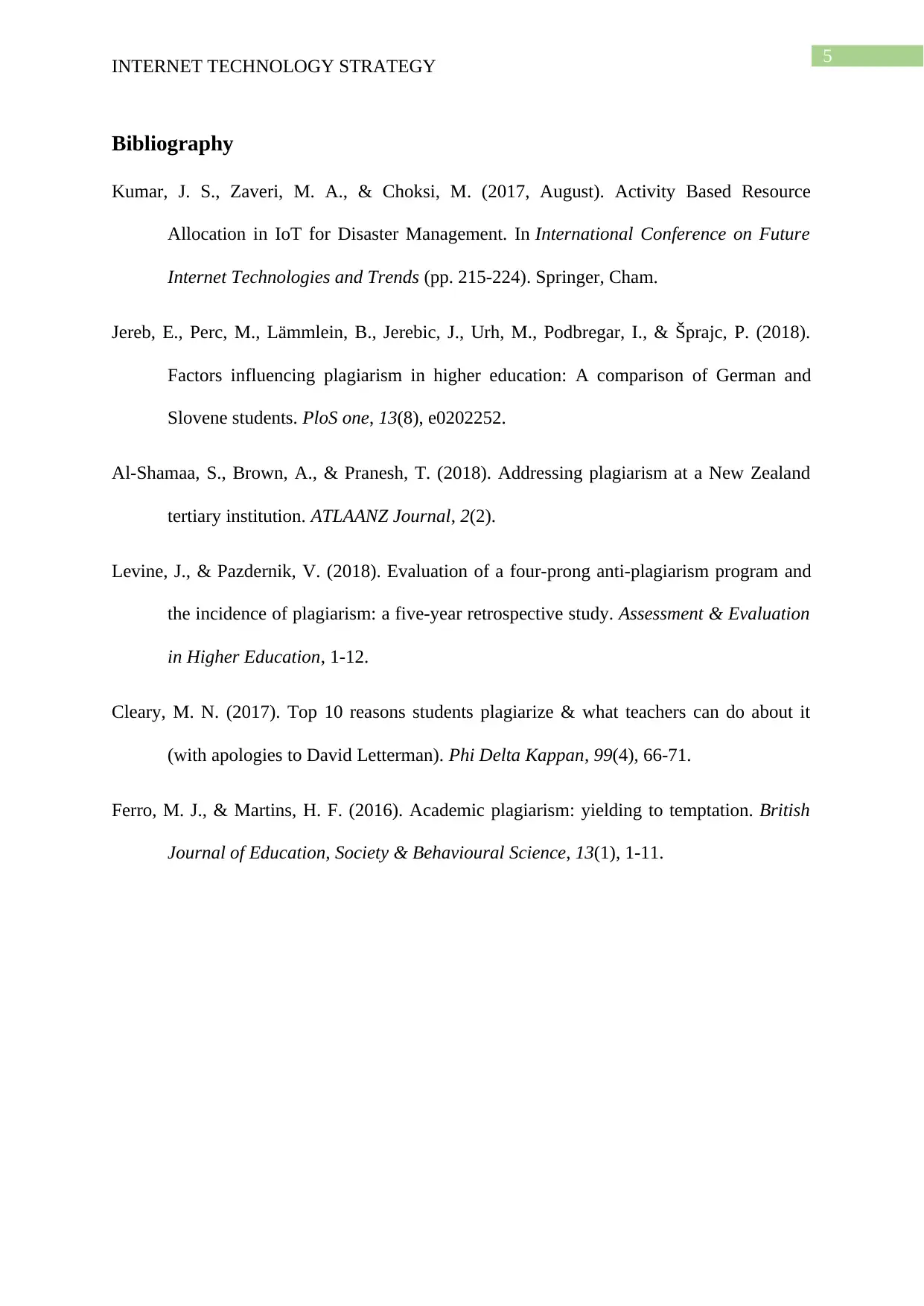
5
INTERNET TECHNOLOGY STRATEGY
Bibliography
Kumar, J. S., Zaveri, M. A., & Choksi, M. (2017, August). Activity Based Resource
Allocation in IoT for Disaster Management. In International Conference on Future
Internet Technologies and Trends (pp. 215-224). Springer, Cham.
Jereb, E., Perc, M., Lämmlein, B., Jerebic, J., Urh, M., Podbregar, I., & Šprajc, P. (2018).
Factors influencing plagiarism in higher education: A comparison of German and
Slovene students. PloS one, 13(8), e0202252.
Al-Shamaa, S., Brown, A., & Pranesh, T. (2018). Addressing plagiarism at a New Zealand
tertiary institution. ATLAANZ Journal, 2(2).
Levine, J., & Pazdernik, V. (2018). Evaluation of a four-prong anti-plagiarism program and
the incidence of plagiarism: a five-year retrospective study. Assessment & Evaluation
in Higher Education, 1-12.
Cleary, M. N. (2017). Top 10 reasons students plagiarize & what teachers can do about it
(with apologies to David Letterman). Phi Delta Kappan, 99(4), 66-71.
Ferro, M. J., & Martins, H. F. (2016). Academic plagiarism: yielding to temptation. British
Journal of Education, Society & Behavioural Science, 13(1), 1-11.
INTERNET TECHNOLOGY STRATEGY
Bibliography
Kumar, J. S., Zaveri, M. A., & Choksi, M. (2017, August). Activity Based Resource
Allocation in IoT for Disaster Management. In International Conference on Future
Internet Technologies and Trends (pp. 215-224). Springer, Cham.
Jereb, E., Perc, M., Lämmlein, B., Jerebic, J., Urh, M., Podbregar, I., & Šprajc, P. (2018).
Factors influencing plagiarism in higher education: A comparison of German and
Slovene students. PloS one, 13(8), e0202252.
Al-Shamaa, S., Brown, A., & Pranesh, T. (2018). Addressing plagiarism at a New Zealand
tertiary institution. ATLAANZ Journal, 2(2).
Levine, J., & Pazdernik, V. (2018). Evaluation of a four-prong anti-plagiarism program and
the incidence of plagiarism: a five-year retrospective study. Assessment & Evaluation
in Higher Education, 1-12.
Cleary, M. N. (2017). Top 10 reasons students plagiarize & what teachers can do about it
(with apologies to David Letterman). Phi Delta Kappan, 99(4), 66-71.
Ferro, M. J., & Martins, H. F. (2016). Academic plagiarism: yielding to temptation. British
Journal of Education, Society & Behavioural Science, 13(1), 1-11.
⊘ This is a preview!⊘
Do you want full access?
Subscribe today to unlock all pages.

Trusted by 1+ million students worldwide
1 out of 6
Related Documents
Your All-in-One AI-Powered Toolkit for Academic Success.
+13062052269
info@desklib.com
Available 24*7 on WhatsApp / Email
![[object Object]](/_next/static/media/star-bottom.7253800d.svg)
Unlock your academic potential
Copyright © 2020–2025 A2Z Services. All Rights Reserved. Developed and managed by ZUCOL.




